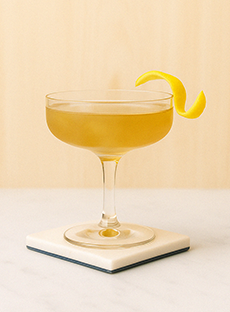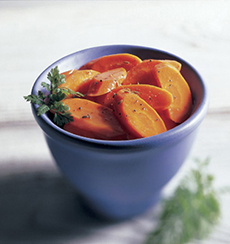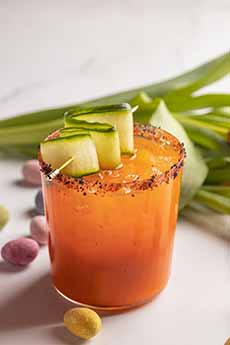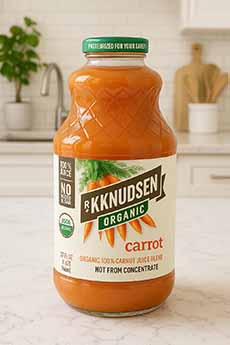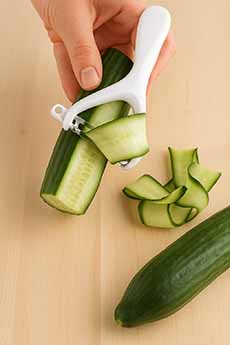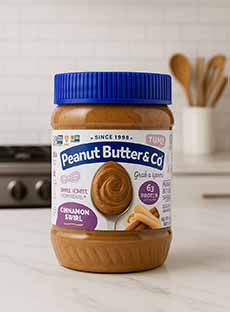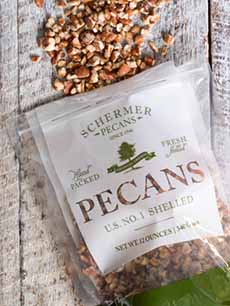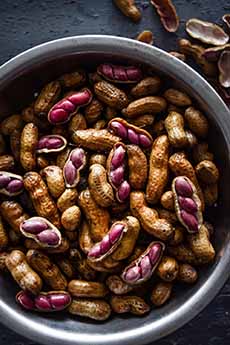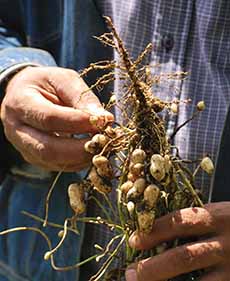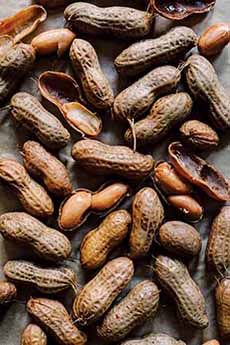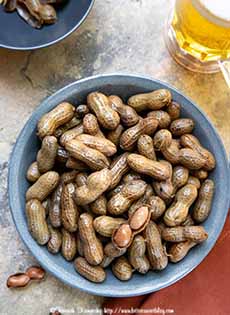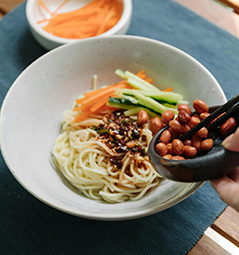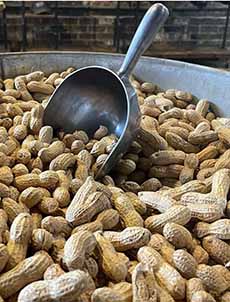|
April 21st was National Chickpea Day, our opportunity to try out this baked potato recipe. We liked it so much that we’re glad that we had extras to enjoy today.
Chickpea Stuffed Sweet Potatoes are protein-packed, gluten-free and dairy-free. Thanks to Bubbies Fine Foods for the recipe, which creatively added their sauerkraut as a garnish.
The recipe would work with white potatoes, too.
> The history of chickpeas and how the chickpea got its name.
> Are chickpeas peas or beans?
> More chickpea recipes.
> The different beans, grains, legumes: a photo glossary.
Below:
> The difference between legumes, beans, and pulses.
> The most popular legume, bean, and pulse dishes in the U.S.
> All the legume, bean, and pulse holidays.
RECIPE: CHICKPEA STUFFED SWEET POTATOES WITH BUBBIES SAUERKRAUT
Prep time is 10 minutes, and bake time is 70 minutes.
Ingredients
4 large sweet potatoes
1 can (15 ounces) chickpeas
1 tablespoon olive oil
1 teaspoon kosher salt
½ teaspoon black pepper
½ teaspoon cumin
1 garlic clove, minced
For The Garnish
2 tablespoons tahini sauce
Garnish: Bubbies Sauerkraut
1 handful of arugula
Preparation
1. PREHEAT the oven to 375°F. Prick the sweet potatoes with a fork and bake for 45 -50 minutes or until tender.
2. DRAIN the chickpeas, rinse with water, and pat dry. Toss them in a small bowl with olive oil, salt, black pepper, garlic, and cumin.
3. EVENLY SPREAD the chickpeas on a sheet pan and bake for 25-30 minutes until browned and crispy. Once the potatoes have cooled…
4. SLICE them in half and top them with chickpeas (if you wish, you can scoop out some of the flesh).
5. GARNISH with sauerkraut, drizzle with tahini sauce, and top with some arugula leaves.
THE DIFFERENCE BETWEEN LEGUMES, PULSES, & BEANS
Legumes, pulses, and beans dominate American recipes. Legumes like peanuts and soybeans are found in many health-conscious meals, processed foods, and snacks. Pulses like lentils and chickpeas become are important in fiber-forward and plant-based diets (not to mention that great “American” snack food adoptee, hummus).
All beans and pulses are legumes, but not all legumes are beans. For example:
Chickpeas are legumes, but they are not beans.
Lentils are legumes, but they are not beans.
Green beans are legumes, but technically not beans (in the sense that they can’t be dried and stored).
Legumes, pulses, and beans are all related, but each term refers to a different level of classification or usage. Here’s how they fit together. Thanks to the Food and Agriculture Organization Of The United Nations (FAO) for the information.
Legumes are the broadest category, which refers to plants in the Fabaceae botanical family. It includes the entire plant: pods, seeds, and structure.
Legume is a botanical term, not a food term. The plants in the legume category do not have to be edible.
Examples of legumes include alfalfa, beans, chickpeas, clover, lentils, mesquite, peanuts, peas (both green and dry), soybeans, and tamarind.
Pulses are a subset of legumes. Pulse is a botanical term. Like legumes, it is not limited to food use. Pulses don’t have to be edible—for example, ornamental* legumes.
Pulses are the dry edible seeds of certain legume plants. They are harvested dry, not green or fresh.
Pulses include chickpeas, cowpeas (e.g., black-eyed peas), dried beans (black, kidney, navy, pinto, and hundreds of others), lentils, mung beans, pigeon peas, and split peas.
Beans are both a type of pulse and a legume. Bean is a culinary term, not a botanical term.
The bean group refers to seeds from specific plants in the Phaseolus (common bean) genus plus a few others. They are most often oval or kidney-shaped.
The bean group includes black beans, kidney beans, lima beans (a.k.a. butter beans), navy beans, pinto beans, and many others.
Note that particular legumes—chickpeas, fava beans, lima beans, mung beans, and others are pulses if they are harvested dry, but legumes if they are harvested fresh.
For example:
Lima beans are always legumes. They’re members of the Fabaceae family, so whether fresh or dried, they’re legumes by botanical definition.
Lima beans are pulses if harvested dry. According to the FAO (Food and Agriculture Organization), pulses are “leguminous crops harvested solely for their dry grain.”
Lima beans are also beans. They are a type of common bean in the genus Phaseolus, just like kidney or navy beans. Beans can be fresh or dried.
Thus, dried lima beans are legumes, pulses, and beans, while fresh lima beans are only legumes and beans.
THE MOST POPULAR BEAN, LEGUME, & PULSE DISHES IN THE U.S.
Bean dishes: baked beans (navy beans), bean burritos (black or pinto beans), bean soup (navy or great northern beans), black-eyed pea dishes, chili (black, kidney, or pinto bean), refried beans (pinto beans, sometimes black beans), three-bean salad (Kidney, green, and garbanzo beans).
Legume dishes: black-eyed pea dishes, edamame (soybeans), peanut butter and jelly sandwich, soy milk and tofu dishes (soybeans), split pea soup (dry peas), stir frys and other Asian dishes (snow peas, sugar snap peas).
Pulse dishes: chana masala (chickpeas), chickpea salad, daal (lentils or chickpeas), falafel (chickpeas or fava beans), hummus (chickpeas, a.k.a. garbanzo beans), lentil soup, lentil sloppy joes, lentil tacos.
ALL THE BEAN, LEGUME, & PULSE HOLIDAYS
We have include some, but not all, of the holidays for the most popular bean dishes.
January 6: National Bean Day / National Dry Bean Day
January 9: National Cassoulet Day
February 7: National Chili Day
February 10: World Pulses Day
April 20: Lima Bean Respect Day
April 21: National Chickpea Day
May 13: International Hummus Day
June 12: International Falafel Day
July: National Beans Month
July 3: National Eat Your Beans Day
July 13: National Beans ‘N’ Franks Day
July 26: World Tofu Day
December 3: National Green Bean Casserole Day
Plus:
All The Peanut Holidays (there are 24, excluding peanut butter holidays)
Plus, For Fun:
April 16: National Bean Counter Day
April 22: National Jelly Bean Day
August 22: Never Bean Better Day
|
|

[1] Ready to celebrate National Chickpea Day in style. The recipe is below (photos #1, #34, and #5 © Bubbies Fine Foods).
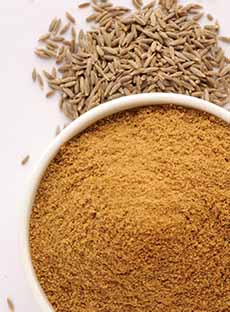
[2] Cumin, part of the seasoning, is warm, earthy, nutty, and slightly peppery. The seeds are used either whole or ground. The spice can be found in global cuisines, especially in India, the Mediterranean, Mexico (and Tex-Mex), the Middle East, and North Africa (photo © The Spice House).
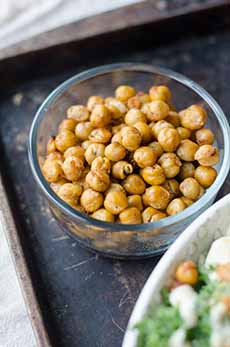
[3] Chickpeas top the sweet potato (photo © Clark Douglas | Unsplash).

[4] They in turn are topped with sauerkraut.
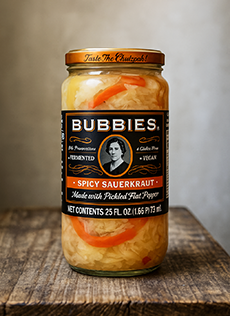
[5] Bubbies Sauerkraut is available in Original and Spicy. You can use either in this recipe.
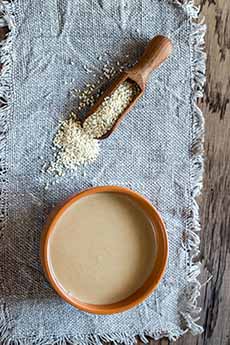
[6] Then, a drizzle of tahini, which is a sauce made from ground sesame seeds (photo © Alex 9500 | Panther Media).
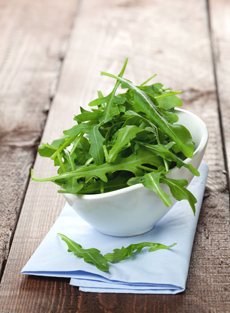
[7] A few leaves of arugula, and you’re ready to eat (photo © Baldor Food | Facebook).
|









